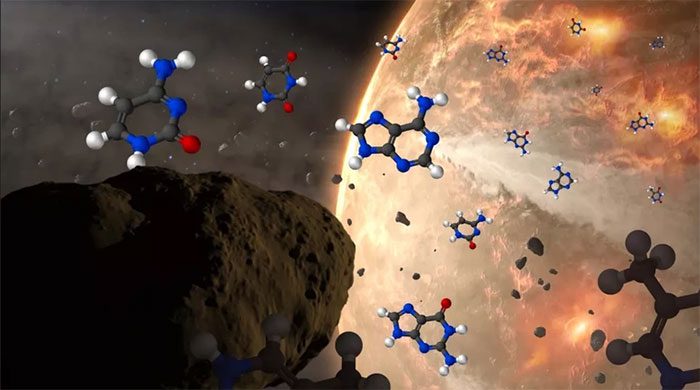Scientists confirm that the essential “genetic letters” of life on Earth can be found in space rocks.
DNA is composed of 4 main building blocks of life (nucleobases), known as adenine (A), thymine (T), cytosine (C), and guanine (G). Meanwhile, the molecule “the sibling of DNA,” RNA, also uses A, C, and G but swaps thymine for uracil (U).

Nucleobases found in DNA and RNA in meteorites that have reached Earth
For a long time, scientists have hypothesized about the origins of these blocks, questioning whether meteorites might be a “train” that brought them to Earth. However, until now, they have only found A and G in space rocks, while T, C, and U remain mysteries.
In a recent discovery, scientists from Hokkaido University in Japan have confirmed that they found the complete set of 5 nucleobases – existing in two forms: purine (with a structure formed from a hexagonal molecule fused with a pentagonal molecule) and pyrimidine (a structure formed solely from a hexagonal molecule).
To reach this conclusion, the researchers analyzed samples from 3 carbon-rich meteorites, including the Murchison, Murray, and Tagish meteorites. Among them, the three missing nucleobases, T, C, and U, were discovered, albeit at very low levels of a few parts per billion, but in sufficient concentrations comparable to those created in laboratory conditions simulating life.
According to the researchers, these nucleobases found in DNA and RNA in meteorites that have reached Earth suggest that the hypothesis of life on Earth being “sent” from the universe may be entirely plausible.
“The presence of the 5 main nucleobases in meteorites may have contributed to genetic functions before life began on Earth,” stated Yasuhiro Oba, the lead author of the study and an astrobiochemist at Hokkaido University.
From these results, Oba and his colleagues even suggest that these “genetic letters” may have existed before the formation of the Solar System and could indeed act as “trains,” carrying life throughout the universe.
The researchers presented their findings in detail in the journal Nature Communications, published on April 26.


















































